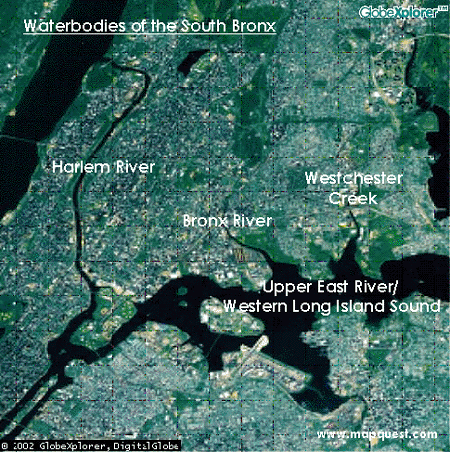The South Bronx waterfront has a rich history, ranging from heavy industry
to summer resort getaways; however, it now faces environmental hazards as
a result of past years of pollution and poor water resource management. This
portion of the study examines the history, water quality and restoration efforts
in the South Bronx’s waters, including the Bronx River, Harlem River, Westchester
Creek and the Upper East River/ Western Long Island Sound.
The map below shows an aerial photograph of the region and its waterbodies.

An examination of the environmental quality of these waters found similar
problems across each. For example, pollutants such as PCBs (polychlorinated
biphenyls), pathogens and floatables have all been of primary environmental
concern in these waters in recent years. Attention has specifically been given
to hypoxic conditions due to low levels of dissolved oxygen in the Western
Long Island Sound, caused primarily by area wastewater treatment plants discharging
excessive levels of nitrogen into the water. Adverse water quality impacts
of inadequate combined sewer overflow facilities also have begun to be addressed.
Bronx River Water Quality
Pathogen contamination has plagued the Bronx River for years and is viewed
as a high priority area for future analysis and restoration. New York State
listed the lower Bronx River as a high priority water body in the 2002 Section
303(d) List of Impaired Waters. Pathogens were listed as the main pollutant,
with urban storm runoff and combined sewer overflow as the main sources of
pollution.
Harlem River Water Quality
Harlem River, an outlet for the Lower Hudson River, is directly affected
by the larger river’s water quality problems. PCB contamination of fish is
a primary concern for both waterbodies. The New York State Department of Health
2002-2003 Health Advisories for Chemicals in Sportfish and Game lists several
fish consumption advisories for the Harlem River
Upper East River/ Western Long Island Sound Water Quality
The level of dissolved oxygen (DO) in the Upper East River/ Western Long
Island Sound has been of primary concern for the past two decades. In the
mid-1980s, water quality engineers recognized that wastewater treatment plants
were expelling excessive levels of nitrogen. High levels of nitrogen produced
algae blooms, creating hypoxic conditions as large amounts of decaying matter
depleted DO levels. Fish in affected waters are forced to move to new oxygen-rich
waters or else face death. In fact, as late as 1999, Long Island experienced
an enormous decline in the lobster population as a result of high nitrogen
levels.
In the late 1980s, the NYC DEP initiated a nitrogen control program
that sought to create new standards for fourteen local wastewater treatment
plants and implement new biological nutrient removal technologies. Since then,
the trend in DO levels has improved. Despite this improvement in DO, the
western Sound still faces some crucial problems as a result of past environmental
mistakes.
In addition to dissolved oxygen, PCB contamination presents a severe
environmental danger. A state health department survey found the Hunts Point
area of the South Bronx to be one of several New York City locations where
residents often catch and eat fish contaminated with PCBs.
Westchester Creek Water Quality
According to New York State, Westchester Creek’s water quality is in satisfactory
condition. Combined sewer overflow (CSO) discharges have been identified as
the source of the sludge/ sediment creating the oxygen demand in the creek.
CSO discharges are currently being addressed with the CSO Abatement Program.
For more information on water quality in the South Bronx watershed,
see Chapter 6, page 76 of the Phase I Report: Water Quality in the South Bronx
Watershed. *Phase I Report.
*You will need Adobe Acrobat Reader to view this file. To
download it for free just click here.

Institute for Civil Infrastructure Systems
Robert F. Wagner Graduate School of Public Service
New York University
411 Lafayette Street. Suite 300
New York, NY 10003
2004
|
|

